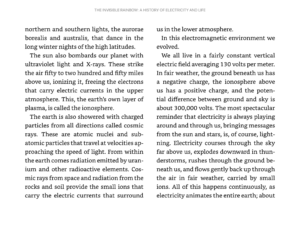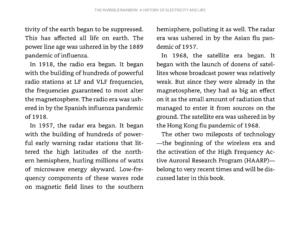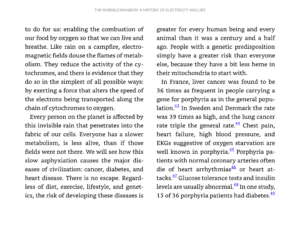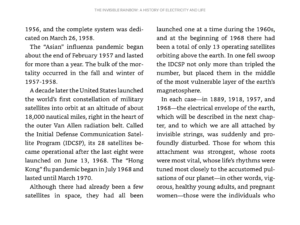The following is an excerpt from an essay by the author of The Invisible Rainbow; A History of Electricity and Life, Arthur Firstenberg, which I recommended last time. I do so again.
IS THE SKY REALLY FALLING?
As I write this, the world — or a very large part of it — is effectively under martial law. To protect against a proposed enemy named coronavirus (COVID-19), schools have been closed, airline flights scrapped, theaters and restaurants shut down, churches shuttered, curfews put in place, public gatherings prohibited, national borders closed, people told not to touch or go near each other, every surface, door knob and human hand smothered with toxic disinfectant, and the population ordered to “shelter in place” in their homes.
And the people, from the USA to Norway to Bolivia to Australia to Egypt to Indonesia, have obeyed, not only without much protest, but with enthusiasm.
My inbox and voicemail are flooded with contradictory “information,” little of which is verifiable, less of which makes any sense, that is tailored to favorite points of scientific and political view. No one is looking at the big picture. No one is noticing that the mortality rates from all causes are going down, not up in most countries.
WHAT CAUSED THE 1918 “SPANISH INFLUENZA”?
This is not the first time a scare about a viral pandemic has swept the world. We have previously heard predictions — none of which came true — that swine flu, bird flu, SARS, MERS, West Nile virus, Zika virus and Ebola were going to kill millions of people. Notably, all of these scares have occurred after the Internet replaced human contact as the predominant means of communication, and words and pictures on a screen replaced reality. Today, this has gone so far that people are finally willing to shut down the world rather than notice what is going on around them.
 I do not pretend that there is no basis at all for these predictions. Behind all the hysteria is a fear that the catastrophe that was the “Spanish Influenza” of 1918-1921 will repeat itself. The 1918 flu, after all, sickened one-third of the world’s population and killed an estimated fifty million people.
I do not pretend that there is no basis at all for these predictions. Behind all the hysteria is a fear that the catastrophe that was the “Spanish Influenza” of 1918-1921 will repeat itself. The 1918 flu, after all, sickened one-third of the world’s population and killed an estimated fifty million people.
But there are a number of important facts about the 1918 flu that are not widely known:
• The 1918 flu was not caused by a virus.
• The 1918 flu was not contagious and did not spread by direct human-to-human contact.
• The 1918 flu began on U.S. military bases where soldiers were being trained in wireless telegraphy. It spread throughout the world on U.S. Navy ships. Over 10,000 state-of-theart wireless stations were deployed by the U.S. Navy during World War One. The flu became much more deadly in September 1918 when the first round-the-clock voice radio station powerful enough to be received in most parts of the world went on the air in New Brunswick, New Jersey in service of the U.S. war effort, thereby launching the modern era of radio communication. Efforts by doctors working for the U.S. Public Health Service to prove the contagious nature of the 1918 flu were heroic and resulted in resounding and repeated failure. In November and December 1918 and in February and March 1919, they attempted to infect one hundred healthy volunteers with influenza in the following ways:
• They put secretions from the mouth, nose, throat and bronchi from hospitalized influenza patients into the nose,  throat and eyes of volunteers; • They injected blood from sick patients into volunteers; • They filtered mucous material from sick patients and injected it under the skin of volunteers;
throat and eyes of volunteers; • They injected blood from sick patients into volunteers; • They filtered mucous material from sick patients and injected it under the skin of volunteers;
• They had volunteers shake hands with sick patients, talk to them, faces close together, for five minutes, then had the patient breathe out as hard as he could while the volunteer, two inches away, was breathing in, then had the patient cough directly into the face of the volunteer, five times. None of the volunteers in any of these experiments got sick in any way.
Similar attempts to infect healthy horses with secretions from horses sick with influenza resulted in the same resounding failure. These experiments, and other facts about the 1918 flu, as well as about influenza in general, are thoroughly discussed and documented in chapters 7, 8 and 9 of my book, The Invisible Rainbow: A History of Electricity and Life (AGB Press 2017, Chelsea Green 2020).
Historically, influenza was an unpredictable disease that struck without warning and without a schedule and disappeared as suddenly and mysteriously as it had arrived, not to be seen again for years or decades. It did not exist on this earth as an annual disease prior to the worldwide deployment of AC electricity for lights and power that occurred in 1889. Many of the doctors who were flooded with influenza in 1889 had never seen a case before.
 But influenza has not been absent anywhere on earth since.
But influenza has not been absent anywhere on earth since.
What is most difficult for people to let go of is the notion, so deeply engrained in our society, that a disease is the same as a bacteria or a virus. This way of looking at the world, as a battlefield instead of a community, is wrong. Yes, there is a respiratory virus associated with influenza. No, the virus does not cause the disease. Influenza is a neurological disease that can affect almost every organ, with or without respiratory symptoms. It is caused by electricity. [end excerpt]
You can read the rest of it here, but I recommend you go right to the book. He may not be 100% right about everything but just consider the above information about the 1918 outbreak, and the fact that no one has been able to prove that viruses cause disease.
Look at what’s going on around us and consider this. (Then read the book; I want to hear your take on it.)



21 comments for “The Invisible Rainbow”